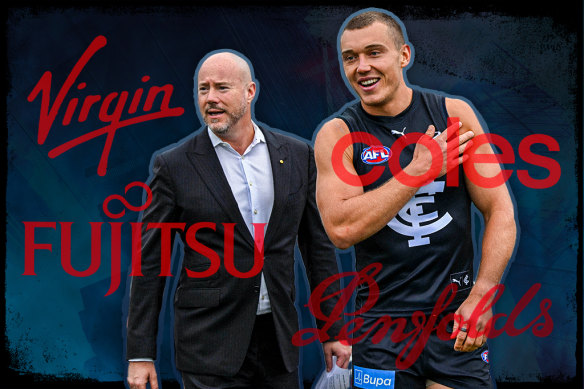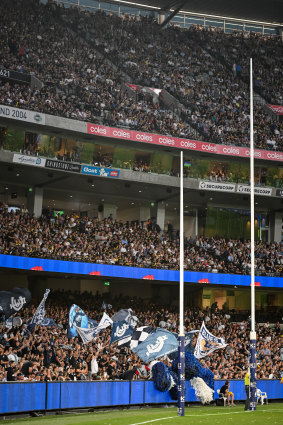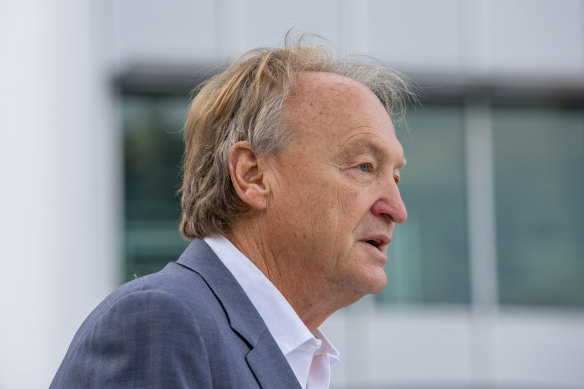By Jake Niall
The most striking difference that Brian Cook identified between Carlton and Geelong was in how each club’s people barracked and in how the more extreme Bluebaggers dealt with victory and defeat.
“The true uniqueness I found, in comparison, was just the passion of its supporter base at Carlton – its width, its depth, its tentacles where they spread,” said the veteran Carlton chief executive, who held the same position at Geelong for 23 years.

Carlton president Luke Sayers and captain Patrick Cripps. The club has strong relationships with the corporate world.Credit: Artwork: Bethany Rae
“And when you win it’s like a family party and when you lose it’s like a funeral.”
Geelong people, while not lacking in passion, were less vociferous. “At Geelong, whilst they’re a passionate group, they’re a quiet passionate group, and they barrack inside their heads. They’re not audible. That’s the difference I found in the emotion in the behaviour of supporters.”
Noisy city club. Quieter country club.
Cook is seeking to change Carlton’s tendency to overreact. Without saying it, the CEO’s intentions echoed Rudyard Kipling’s famed line: “If you can meet with those two imposters, triumph and disaster, and treat them just the same.”
Cook’s version: “I’m trying to find a better balance in that, but that’s more long term in terms of changing DNA a bit.”
How Carlton and Geelong celebrate and commiserate is but one of the differences between the clubs who meet this weekend in one of the higher-stakes games of 2024 to date.
Each club’s supporter base, geography and history begat distinctive cultures. As CEO at the Cats during the period in which they morphed into a regional juggernaut, Cook understands Geelong’s competitive advantage as a business.
“In terms of the businesses, they’re footy business. Geelong has a stadium and now 40,000 capacity and now keeps 99 per cent of the income, so it has a huge advantage from a stadium point of view.
“We’ll have 100,000 members soon ... we’re about 99[000] right now. That’s our uniqueness, we make from a financial point of view, that’s where we make the bulk of our dollars.”
Geelong’s recruiting model was more localised – the Cats have 18 players on their list from greater Geelong, the Surf Coast or western Victoria. Cook observed that the Cats also prioritised players from “regional” Australia, whereas the Blues weren’t confined geographically [Sam Walsh and Charlie Curnow, indeed, are from Geelong’s heartland]. “The issue for us is to get good players.”
Cook reckoned that the fervour of Carlton masses represented a competitive edge. “The passion of our supporters is unbelievable ... The issue for people like me is to harness that.”
Cook agreed, though, that the Blues had a similar profile and appeal to high-drawing Victorian rivals Collingwood, Richmond, Essendon and Hawthorn.
“There’s four of us, or five of us, that sort of high-drawing crowds, all just about 100,000 members – and how to create differences between those?”
Carlton created one major point of difference, which Cook and the Luke Sayers-led board hope can turn into a competitive edge: Their business network.
On Wednesday, the Carlton In Business network hosted nearly 1000 guests at Crown’s Palladium. It is a measure of Carlton’s networking clout in Melbourne that the event attracted the CEOs from Virgin, Fujitsu, Bunnings, Great Southern Bank, Reece Group, Bupa Health and a senior executive of Kellogg Brown and Root – all of which are signed up to Carlton In Business, along with Coles, Penfolds and EY.

When Carlton succeed, the Bluebaggers come out in force.Credit: Justin McManus
Ex-Richmond skipper Trent Cotchin and ex-Hawk premiership player Brad Sewell were among Wednesday’s throng, both representing companies in the CIB network, which is a vehicle for businesses to deal with one another.
Ex-Blues Stephen Kernahan (John Lyng Group), Michael Jamison (AFLPA), Jim Buckley (Whiteman Property) and Simon White (Escala Group), too, were there to hear Sayers and keynote speaker Amazon Prime executive David Carbon and to meet and mingle. For the Blues, the pay-off is to put CIB members together through the network – plus the fees and sponsorship they contribute to Carlton.
The Blues have about 160 companies signed up for the Carlton In Business network, with each paying $13,000 each.
The signature example of Carlton-driven deals was of Virgin, a club major sponsor, providing two full planes to fly CIB guests to Adelaide and Penfolds, a CIB sponsor, to buy truckloads of wine last year.
Cook observed that the Blues were netting about $5 million from non-footy income, $2 million to $3 million of which derives from gaming (via club benefactor Bruce Mathieson-run venues) and that non-football business shaped as an area in which they stood out.
The Carlton boss said that the Blues accounted for $5 million of non-football income, from a modest industry net aggregate of $17 million (philanthropy is not counted).
“It’s not a lot – of which we have five [million dollars].
“Some have got investment arms – we’re looking at that ourselves, investment account. Some have got food and beverage, some have got gymnasiums like Richmond ... gaming and education.
“But generally speaking, we’re not good at it when you think about the whole industry making only $17 million from non-football activity in $1.2 or $1.3 billion in footy activity. It’s bread crumbs.
“I don’t think we do it fantastically well in the industry ... we do it as well as anyone here at Carlton.

Carlton CEO Brian Cook.Credit: Getty Images
“Whether you can make that into a competitive advantage is debatable. If someone said, ‘What are the uniquenesses of Carlton?’, this could be one.
“So there’s a couple of competitive advantages. But certainly the non-footy side, I think we’re a standout there.”
Several past Carlton players – Mil Hanna and Matt Kreuzer to name two – have been employed by CIB companies. But Cook said no current players were employed by network members. The Blues, clearly, are mindful of not pushing the envelope on AFL rules surrounding third-party payments to players.
“There’s not one of our players employed by that, those 160 companies, not one. Not one current player,” said Cook.
“In terms of our ex-players, yes we have several, so you’re dead right, it’s more about post-career.
“Some of the players do some work experiences with those groups at the moment, yeah some of the current players, in order to get ready for post-careers. But none of them are employed at this stage.”
Geelong, which gained financially from late seminal former president Frank Costa’s munificence and local powerbroker influence and that of Geelong-based clothing giant Cotton On, have no comparable business network.
“There’s no Geelong in business at Geelong,” said Cook, “And in fact I think most of the sports clubs that have tried to set up [a business network] haven’t been successful, albeit I think Melbourne Storm are relatively successful, the AFL have started ... you know, not many are doing it.”
Notorious as a club that was heavily influenced by billionaire families such as that of Mathieson and the late Richard Pratt (and previously the wealthy Smorgon and well-connected Kerr families), Cook – who was criticised by Mathieson during the team’s mid-year travails last year – explained how the Blues wanted billionaires in the fold, without reliance upon them.
“You don’t want to wean yourself off their support. They’re good people. But you can’t rely on them, you can’t be – for want of a better term – highly, highly committed to what they want us to do. We’re Carlton, we have to develop healthy governance process and be inclusive of all of our people.”
Keep up to date with the best AFL coverage in the country. Sign up for the Real Footy newsletter.